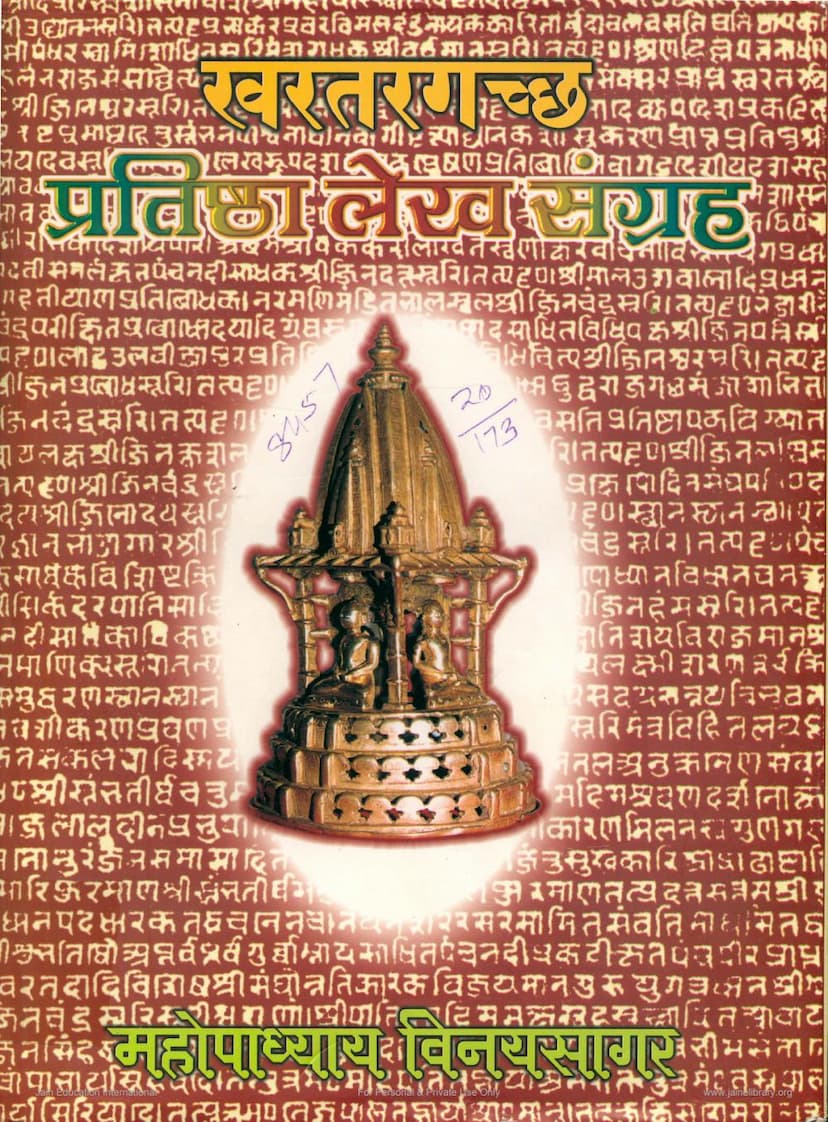Khartargaccha Pratishtha Lekh Sangraha
Added to library: September 2, 2025

Summary
Here's a comprehensive summary of the Jain text "Khartargaccha Pratishtha Lekh Sangraha" authored by Vinaysagar:
Book Title: Khartargaccha Pratishtha Lekh Sangraha Author: Vinaysagar Publisher: Prakrit Bharti Academy
This collection, compiled and edited by Vinaysagar, is a monumental work that offers invaluable insights into the history of Jainism, particularly focusing on the Khartargaccha lineage. It comprises 2760 inscriptions, dating from the 11th to the 20th century CE.
Core Significance:
- Historical Documentation: The primary value of this collection lies in the "Pratishtha Lekh" (inscriptions on installed idols). These inscriptions are crucial primary sources for reconstructing Jain history. They meticulously record details about the patrons (Upasakas), their time, caste, and lineage (Gotra), as well as the Jaina Acharyas and other monastic figures involved in the installation ceremonies.
- Contribution of Khartargaccha: The collection demonstrates the significant role of the Khartargaccha in spreading Jainism across India. It highlights how the Acharyas of this lineage inspired wealthy lay followers (Shravakas) to contribute to the construction, renovation, and consecration of numerous temples and thousands of Jina images in diverse regions like Bihar, Bengal, Himachal Pradesh, Punjab, Uttar Pradesh, Rajasthan, Saurashtra, Gujarat, and Madhya Pradesh.
- Restoration of Agamic Practices: The book emphasizes that the establishment of the Khartargaccha was a revolutionary movement against the perceived laxity (Shithilachar) of the Chaityavasi tradition. It aimed to re-establish the Jinopadishthita Agamic conduct, thereby strengthening the monastic order (Shramanadhara).
- Khartargaccha's Antiquity and Contribution: It asserts that among the currently existing gacchas (sects or lineages) in the Shvetambara tradition, the Khartargaccha is the most ancient. Its contributions to society, literature, and the broader sphere of Jain philosophy and culture are deemed unforgettable.
- Influence on Rulers and Society: The text points out that the Khartargaccha Acharyas not only influenced the general populace but also inspired contemporary rulers through their teachings. They played a vital role in the formation of various communities and Gotras, such as the Osvansh, showcasing their extensive societal impact.
- Source of Historical Information: The collection provides a wealth of new historical data, serving as a guide to the noble sentiments of Jain culture and offering authentic narratives for resolving historical queries.
Key Contents and Structure (as indicated by the table of contents):
The book is structured to provide a comprehensive understanding of the inscriptions and the context surrounding them. It includes:
- Introduction (Prastavna): Likely a general overview of the book's importance and the significance of inscriptions.
- Foreword (Purovak): This section appears to be a detailed discussion on the importance of epigraphy for Jain history, the challenges in preserving inscriptions, the history of collecting them, and the specific contributions of the Khartargaccha. It likely includes biographical details of prominent Acharyas and patrons.
- Collection of Inscriptions (Pratishtha Lekh Sangrah - Mool Lekh): This is the main body of the work, containing the actual text of the 2760 inscriptions.
- Appendices (Parishisht 1-7): These appendices are crucial for research and provide:
- An index of books cited in the collection.
- A list of places where the inscriptions were found.
- An index of Acharyas and monks mentioned in the inscriptions.
- An index of kings and other rulers mentioned.
- An index of villages mentioned.
- An index of castes (Jatis) mentioned.
- An index of Gotras mentioned.
Notable Aspects Highlighted in the Text:
- Chronological Range: The inscriptions span from the 11th century CE up to the 20th century CE, providing a long historical perspective.
- Geographical Spread: The Khartargaccha's influence is shown to be widespread, with temples and inscriptions found in numerous states across India.
- Content of Inscriptions: Beyond just names and dates, many inscriptions contain detailed historical information, including royal genealogies, descriptions of patrons' families, and their charitable activities.
- Preservation of Jain Heritage: The text implicitly and explicitly discusses the importance of preserving these historical records, lamenting the neglect and destruction of ancient inscriptions due to carelessness or sectarian rivalry.
- Author's Contribution: Vinaysagar's extensive research, meticulous compilation, and scholarly editing are recognized as filling a significant void in Jain historical literature. His dedication to the cause of Jain heritage is highly praised.
- Inspiration and Dedication: The book is dedicated to the propagation of humanity's development and the preservation of historical evidence, emphasizing the profound role of faith and the sanctity of Jina temples.
In essence, "Khartargaccha Pratishtha Lekh Sangraha" is a foundational scholarly work for anyone interested in the detailed history of the Khartargaccha and Jainism in India. It serves as an indispensable resource for historians, researchers, and students of Jainology, offering primary data that underpins historical understanding and cultural appreciation.